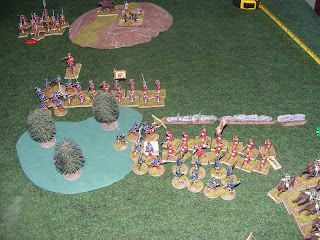Pietro di Calvacasa arrived near a farmstead close to the walls of Civita Maria. His small army was visible from the towers of the old fort, and the garrison commander was eager to march against it.
'Sire, I think the rebels have acquired siege guns', a scout reported as the battalions assembled near the gate. 'We have spotted them on a hill, overlooking the western walls.'
'But Christ, those are the weakest of all', the General said, 'we better hurry and chase these traitors back to their hovels!'
Calvacasa's attack force consisted of two 120-men household battalions after the Varangian fashion, and a group of 80 militia. The culverins seen by the scout were actually logs painted black and placed on fake carriages. The count ordered some peasants to act like tending to the cannon. He hoped this increased threat would entice the very large mouse to scurry out of the tunnel and measure its strength against the very small cat.
The loyalist main force consisted of three provincial battalions and a howitzer. On the left flank a squadron of provincial dragoons was placed, while on the right a full company of Cacciatori was ready to rush to the farmyard and repel any attacks.
Calvacasa divided his two experienced companies to three units, two 80- and one 100-men. The strongest was placed on the open right. If the other half of the army arrives in time, this company would be the pivot point along which the rebel army moves, rolling up the loyalist line.
The provincial infantry was reluctant to charge the enemy. Their firepower was on par with the rebels', though, so the battle began with exchanged volleys.
The militia reached the farmyard sooner than the enemy light infantry and fired at the provincials' flank.
Against all odds, the household infantry on the right held out and repulsed the enemy cavalry charge. The center unit quickly moved into the woods and pinned the provincial infantry down with more musketry.
On the left, the rebel charge broke the enemy line.
The garrison commander managed to rally the battered lines and make the unit return to the fight.
Then all three rebel infantry units charged the provincials.
The enemy was pushed back, but Calvacasa's men had to rally to continue. There was a lull in the action as the loyalist general dressed his lines as well.
The reinforcements arrived later than the Count expected, but the battle was not yet lost. Captain d'Arson received a splinter in his leg when the path was being cleared, so his second-in-command led the reserve.
The right flank repulsed another cavalry charge then chased the enemy off the field.
The Cacciatori broke in face of the outnumbering rebel force. Their way of escape was, however, cut by the Glambrian mercenaries. They laid down their arms.
The rebels now had to engage the remaining enemy forces so they could not retreat. Even a small garrison returning to the fortress would have meant a long siege without proper equipment.
Fortunately the last strike was dealt and the loyalist general ordered his units to surrender. The ruse worked, the trap had been sprung, and Pietro di Calvacasa was on his way to become master of Northern Quattro Formaggi.
Notes: in this instance, the egg came first and then the hen hatched. What I mean is I sat down and began playing without any written rules. I just went along with what seemed right, and when the battle was completed, I wrote it down. This effort manifests itself in Easy Tricorne Battles, also accessible from the Random&Creative Rules page. Sure, it borrows stuff from here and there, and should cover some aspects I left out, but it is playable as is.
The new gaming mat works well with larger scale figures, which reminds me that had there not been some more modern (converted Napoleonic) figures on the table, this could as well have been a GNW battle between Saxons and Swedes.















Nice read and looks great :)
ReplyDeleteThank you!
Delete